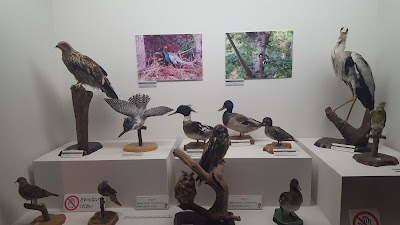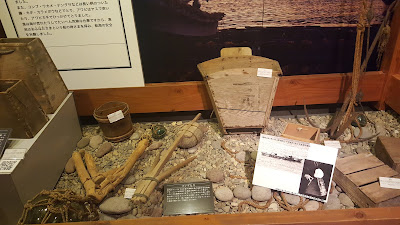友達がゴールデンウィーク中東京から青森に来て一緒に行動することになった。今日はお昼頃に合邦公園で花見する予定なので、その前はみんなで青森県立郷土館を探索してみた。入館料は350円。個人的に面白いと思った。
Aomori Prefectural Museum / 青森県立郷土館
First we have a many artifacts dating from the Jomon period (14,000 BCE - 300BCE).
郷土館入館するとやっぱり最初目に入るのが縄文時代の品々。
This is called a dogu, it was a very common item found in the Jomon period.
これは土偶と呼ばれ、縄文時代から発見されたものです。
Animals that are indigenous to the Tohoku area. A raccoon dog, a fox, and a badger.
東北に生存してる動物たち。狸とキツネとアナグマ。
More animals you may spot in the wild in the Tohoku area.
東北で見かける動物たち。
A model of the Naumann Elephant, an extinct species. Fossils and bones were found, first in Yokosuka in Kanagawa Prefecture. Scientists originally thought this was a different species, smaller than the Naumann and called it the Aomori Elephant.
ナウマンゾウ、絶滅した動物。青森に化石が発見され、科学者たちがナウマン象おり小さいからアオモリゾウで名付けられたが、いろんな研究を重ねて、ナウマンゾウに間違いないとの結果になった。
Interesting looking instrument.
ちょっと変わった楽器ですね。
This is fascinating. A koudokei (incense clock). A clock that measures time according to the burning speed of incense.
初めてみた。香時計というものらし。
Looks like some items from wartime Japan.
まだ日本が大日本帝国と呼ばれた時期のものでしょう。
Some kind of pump, called a wanyo pump.
椀用パンプ。よくわからない。
This is a plow.
これはプラウだ。
Some Showa era cameras?
昭和時代のカメラだったかな。
"Hello!"
"もしもし!”
More Showa era items.
やっぱ昭和時代の品々。
I'm familiar with Ogon Bat on the bottom left and Kyojin no Hoshi at the top right. I even had a few 45s like these that are displayed.
黄金バットと巨人の星、自分は知ってる。こういうレコードも持ってた。
Nebuta / ねぶた
Artwork by Aomori artist Munakata Shiko I think.
青森出身のアーティスト棟方志功の作品だっと思います。
Straw figure / 藁人形
Nebuta Festival items / ねぶた祭り
Wow, this is called a tabetobako which was carried by various vendors called tabeto. They would sell everyday items like clothes, candles, needles, etc.
また珍しいものと思った。たべと箱というものだ。人がこれを背負っていろんなものを販売したという。
Some traditional meals in the Tsugaru area.
昔の食事。
The meals all look pretty healthy.
健康的な食事にしか見えない。
Farming tools / 農業で使うもの
This looks pretty cool.
これもカッコイイな。
A Showa era kitchen. I'm sure that thing on the right is a rice holder and measures out different amounts of rice that you want to cook.
昭和時代の台所と家電だ。
A dial phone, remember those?
ダイル電話、懐かしい!
I remember televisions like this one too.
こういうテレビも見覚えがあるな。これも懐かしい。
A little more about Aomori artist Munakata Shiko.
また棟方志功についての情報。
That's it for the museum. Now, time for us to head off to Gappo Park for a little cherry blossom viewing.
青森県立郷土館の探索が終了。これから合邦公園で花見だ。














































































